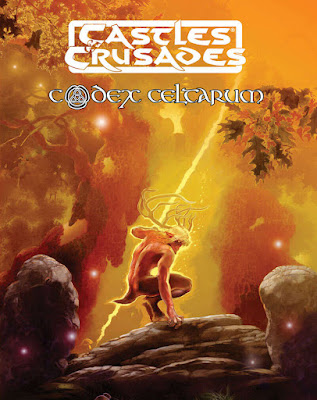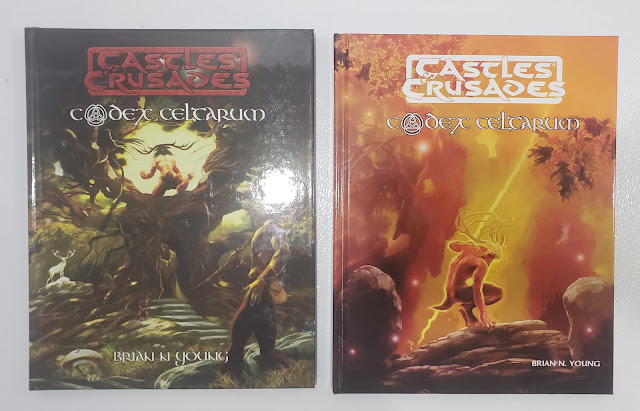For this review, I am considering both he PDF and hardcover copies. 256 pages with color covers and black & white interior art.
The first thing I noticed in his introduction was his acknowledgement of the differences in legend and in history and where he was putting his cards. For me, as someone that has had to have the same tug of war, the value of this book went up several degrees.
Chapter 1: In Lands Far Away
This covers the lands of the Celts and how the Castles & Crusades player can drop their game into this world. The advantage here is this 2nd Edition does talk about how you can use the Codex Germanica along with this. This covers not just the expected British Isles, but all (mostly all) Celtic Europe.
Chapter 2: Mythical Locations
This brief chapter discusses mythical locations like Hyberborea and the Hercynian Forest. These lands were assumed to be real just "over there."
Chapter 3: Once Upon A Time
This chapter covers the history of the Celtic real-world universe including the various wars that happened at the dawn of time and various involved countries/lands in Europe.
Chapter 4: Otherworldly History
This is the "myth" part of the mytho-historical background of the Celts. It overlays the stories of the gods and other powerful beings on top of the history of the Celts. This chapter is rich in storytelling and follows a tale very familiar to me, but there are always new things to read and learn.
Splitting Chapter 3 and Chapter 4 into two separate and distinct chapters is good since for most books on the topic they are intertwined so much that it is hard to tease out the "myth" and the "history" from the mytho-historic events. Certainly one has had a profound effect on the other and I think Young demonstrates this well.
Also while I am 100% behind his enthusiasm here (and I share it) we have yet to see anything game-related and we are 75 pages in.
Chapter 5: The Otherworld of Faery
This chapter covers the various "otherworlds" (yes plural) of the lands of Faery. Usually tied to a physical location in the real world. It reads like an unreal Gazeteer of Europe to be honest, a mist-shrouded tour into a land that is similar but still very different. The faery lands don't have the same rules of nature as the mortal realms. So there are some tables about the odd passage of time or the nature of the land.
Chapter 6: There Lived a People
ALmost everything you want to know about the Faery races. This includes traits faeries can have and their weaknesses. This also includes a list of the giants of Wales.
Chapter 7: Great of Magic and Power
This details, what else, magic. If human wizards study magic and human priests pray for it then the Fae ARE magic. The distinction is not a subtle one. The magical powers here are listed as spells. So they can be used by the fae as if they were spells, but that robs them of what makes them so interesting. Instead, go with the suggestion in the book that each member of the fae gets a number of special powers based on their intelligence. And there are plenty of powers here! If you are anything like me and love magic, spells, or powers for characters then this chapter alone is worth the price of the book.
It is one of the largest chapters so far and has the most "game" material.
Chapter 8: With Great Gods and Lords
This covers the gods, demigods, and named faeries of the lands. There are no stats for these gods or heroes. Why? That is easy. They are not meant to be killed or even interacted with. They are the legends of this land. If you have any familiarity with the gods of Celtic myth and legend you can find them here.
Appendix A: The Druidic Order This covers the druid classes for Castles & Crusades within the Celtic world. There is the Druid (Wisdom), the Celtic Bard (Charisma), and the Druidic Seer (Wisdom).
Appendix B: The Secrets of the Druids This appendix covers the Ogham writing and runes.
Appendix C: Druidic Spells What is says, the spells the various druid classes can use.
At this point, I wonder if all three could not have been combined into one Appendix.
Appendix D: The Enchanted of Faerie Here we get a nice discussion on Faery Metals and how they can be used. There is a list of divine items (artifacts in other games) listed by the owner; that's right the Gáe Bulga is not just lying around waiting for you to find it. No this +8 spear (!) is well in the hands of Cú Chulainn.
Appendix E: The Severed Head discusses the importance of taking the head of your enemy.
Appendix F: The Feast Hall details the Celtic hero's feast.
Appendix G: The Celtic Chariot. what it says on the tin.
Appendix H: The Celtic Warrior Society. Gives us a very brief overview of the importance of warriors and how they were organized. I wish this one had been much longer.
Appendix I: Accoutrements of War. Deals with the arms and armor of the celtic warrior.
Appendix J: Strong Feats and Deeds. Covers the tales of the heroes of the Celtic myths and legends.
Honestly, Appendices E to J should be combined into a chapter on Celtic Warriors. This is what the other Codices have done.Appendix K: Holidays & their Customs.
Appendix L Celtic Themed Adventures.
Appendix M: Monsters
Also, this should have been a chapter. There are 30 pages of monsters here. Many are very familiar to me, but again are closer to their "roots."
Ok. So what can say here?
The book is fantastic and I loved every bit of it. BUT, I find the new organization of the 2nd Printing to be inferior to that of the 1st Printing. I felt some of the material could have been organized and combined a bit better. I still find it a delight to read, but is that due to this book or the subject matter?
Again, there is no doubt that Brian Young is not only an expert in this field, he also loves it. That enthusiasm shows and I am sure he could have written a book twice this size. I do love the expanded history and the raised importance of the continental Celts over the typically well-trodden lands of the Irish and British Celts. Looking over my review of the First Printing this is exactly one of the things I thought was missing from that version. Though some of the material from the first edition (some classes) are missing from this edition. I guess I should keep both on hand.
Still, if you are a fan of Celtic myth, Faery lore, or Castles & Crusades then I highly recommend this book. Even if you don't play C&C, I would get this book.



No comments:
Post a Comment